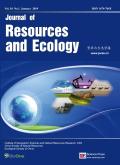Analysis of the Plant Resources and Diversity around the Sifeng Mountain Reservoir in Jiamusi, China
Q3 Environmental Science
引用次数: 0
Abstract
Reservoirs are artificial wetlands with functions such as flood control, water supply, improving livelihoods and regulating the ecological environment. Taking the plants of Sifeng Mountain Reservoir in Jiamusi City as the object of investigation, we studied and analyzed the diversity of plant resources in the reservoirs, aiming to provide a basis for the conservation and use of plants in the reservoirs and the ecological restoration of artificial wetlands. The field trekking method, literature research method, and sample method were used to study the reservoir plant resources in terms of their life types, ecological types, distribution types and plant communities. The survey found 175 species, 137 genera, and 56 families of plants around the Sifeng Mountain Reservoir, including 2 species under National Grade II status. The predominant plant families are Compositae and Rosaceae, while the main plant genus is Artemisia L. Among the six life types, perennial herbaceous plants are dominant, with 86 species, accounting for 49.14% of the total plant population. The ecotype is dominated by mesophytes (118 species), followed by wet plants (56 species) and aquatic plants are the fewest, with only one species. The type of distribution area is clearly temperate. The 16 sample plots were divided into six communities based on species importance, with the plant communities showing a distribution of patches with varying sizes.佳木斯四峰山水库周边植物资源及多样性分析
水库是具有防洪、供水、改善民生、调节生态环境等功能的人工湿地。以佳木斯市四峰山水库植物为调查对象,对水库植物资源的多样性进行了研究和分析,旨在为水库植物的保护利用和人工湿地的生态恢复提供依据。采用实地考察法、文献研究法和抽样法对水库植物资源的生命类型、生态类型、分布类型和植物群落进行了研究。调查发现四峰山水库周边植物56科137属175种,其中国家二级保护植物2种。优势植物科为菊科和蔷薇科,主要植物属为蒿属。6种生命类型中,多年生草本植物占优势,共有86种,占总植物种群的49.14%。生态类型以中植物为主(118种),其次为湿植物(56种),水生植物最少,仅有1种。分布区类型明显为温带。16个样地根据物种的重要性划分为6个群落,植物群落呈大小不等的斑块分布。
本文章由计算机程序翻译,如有差异,请以英文原文为准。
求助全文
约1分钟内获得全文
求助全文
来源期刊

Journal of Resources and Ecology
Environmental Science-Ecology
CiteScore
2.40
自引率
0.00%
发文量
107
 求助内容:
求助内容: 应助结果提醒方式:
应助结果提醒方式:


